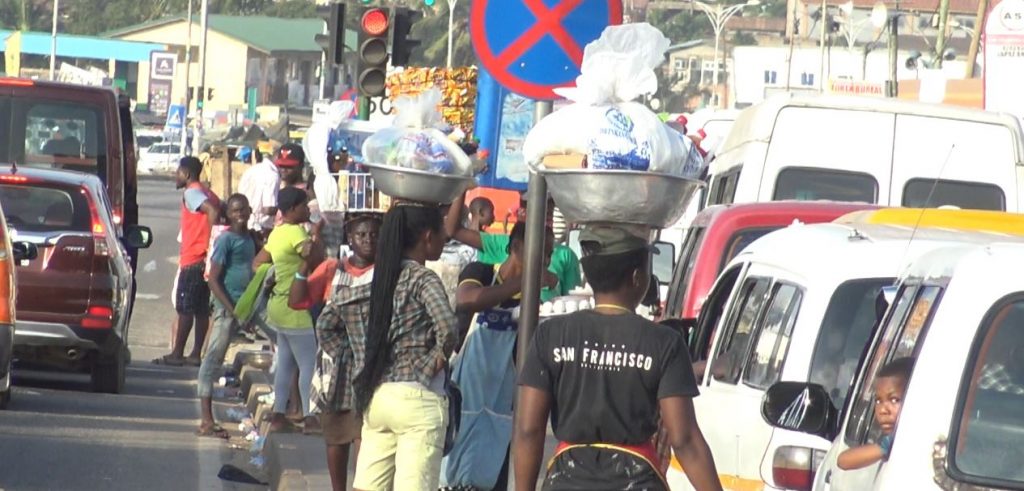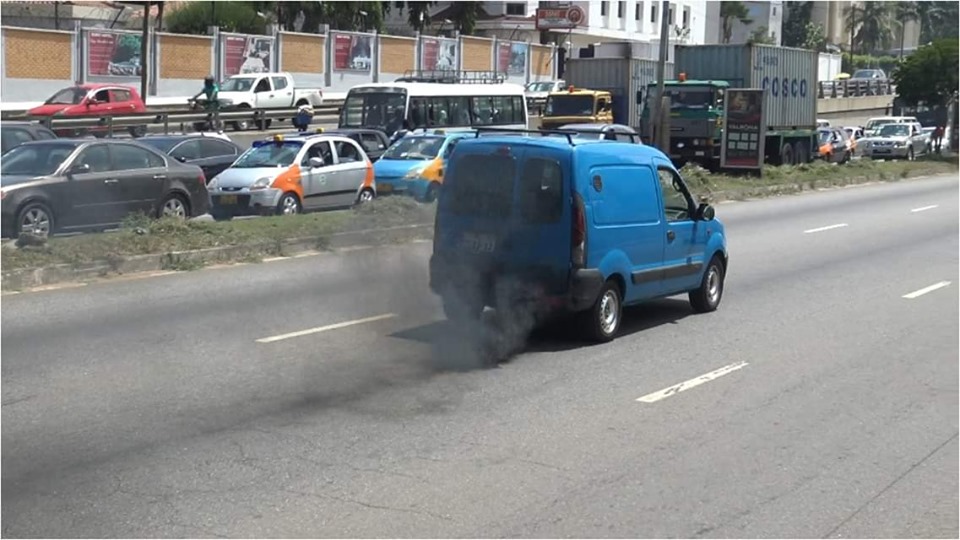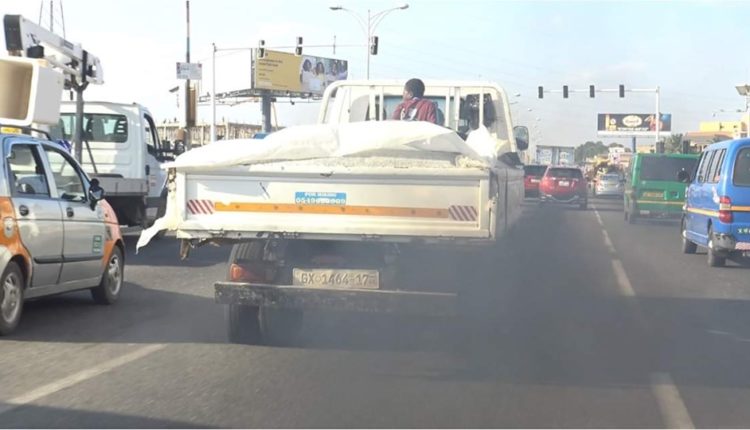Driving through Accra, it is not uncommon to find vehicles emitting thick exhaust fumes that create inconvenience for other motorists.
But beyond the inconvenience, is the serious issue of air pollution and resultant health implications on the over four million inhabitants of the Greater Accra region.
The World Health Organization estimates that about 2,000 people in Accra die every year because of air pollution, with vehicular emissions being a major contributor. This translates into an average of five deaths each day of the year.

Rapid urbanization and population growth in the capital has compounded the problem.
More than 70 per cent of the city’s inhabitants commute via motor vehicles, and worse, spend several hours every week in traffic.
‘Health in jeopardy’
At Lapaz, on the N1 Highway in Accra, Erica Danso sells doughnuts in traffic. Her work involves running after vehicles and drawing the attention of passengers in commercial and private vehicles to her products.
One doughnut sells at GH¢ 1, and for this, she risks her health inhaling exhaust fumes from the many vehicles that drive past her or stop by her before the traffic light.
She has been in the business for more than three years and complains of regular chest pains and she is certain that it has links to her long exposure to toxic exhaust fumes.
“It is a problem for me,” she said.

She continued, “the smoke emitted leaves us with many health issues. I cough when I inhale the fumes.”
Erica’s situation could be a bigger problem, public health advocate and researcher, Benson Owusu Atuahene believes.
He says long-term exposure to exhaust fumes could lead to death from leukaemia.
“Carbon monoxide from vehicle fumes once they get into your system, get bound to the red-blood cell which is meant to circulate oxygen through the body so when this happens, it causes suffocation and could trigger asthmatic attacks.
“Benzene is known to contain carcinogens and it has an effect on the bone marrow and so can lead to leukemia in the long-term. Sulfur dioxide, also present in motor vehicle emissions, can also result in respiratory tract infections,” he said.
Isaac Tetteh is asthmatic and is aware of the effects of vehicle fumes on his health. For this reason, he does not move out without handkerchiefs.
“I am asthmatic and anytime I inhale such fumes it triggers an attack. I am forced to always hold handkerchiefs whenever I am on the streets or in trotro [commercial vehicle]”
For Fred Duhoe whose regular commute in the city is via a personal motorbike, holding his breath is one of the things he does to avoid inhaling toxic fumes from the many smoky vehicles he encounters on the road.
“I ride my motorbike to work everyday and when I’m behind these vehicles with thick smoke from their exhaust, I’m left with no option than to block my nose until I ride past them,” he said
‘Inability to enforce laws’
The Road Traffic Regulations of 2012, L.I 2180 also warns against the use of motor vehicles that emit fumes noting that “an owner or a person in charge of a motor vehicle shall take precaution to ensure that the motor vehicle does not discharge, combustion products, steam, lubricating oil or other substances on the road.”
This regulation has been difficult to enforce because it is vague and subjective.
Superintendent Alexander Obeng, Head of Education, Research, and Training of the Motor Traffic and Transport Department, MTTD, of the Ghana Police Service, admits this challenge.

“That is how far our policy went, as to the level of discharge, we were not told and therefore it allowed itself for discretion. It is not scientific,” he said.
Adding that “we are happy that this deficiency prior to the enactment of the Act and L.I. has been sighted”
‘No emission standards’
There are no functional scientific emission standards in Ghana, at least for now.
There are however proposed limits for vehicle emissions, beyond which vehicles will be considered in breach.
For instance, petrol cars manufactured before 1995 are limited to emitting a maximum of 800 parts per million of hydrocarbons and those manufactured after 1995, at 300 parts per million hydrocarbons but that is yet to be given legal backing.
The Driver and Vehicle Licensing Authority (DVLA) which is responsible for inspecting and issuing licenses for motor vehicles in the country, issues smoky vehicles with roadworthiness certificates, if they meet the other criteria for the issuance of the certificate.
This is despite the high risks they pose to the environment and human health.

Smoky vehicles will continue to be passed to ply the roads in Accra so long as there are no emission performance standards backed by law in the country.
This has limited the function of the about 36 vehicle inspection stations in the country to offering advice to car owners whose vehicles are determined, based on visible signs, to be smoky.
The Head of Research at the DVLA, Abraham Zaato said a national emission performance standard backed by law will soon be made public to ensure that cars that are permitted on the roads do not jeopardize air quality.
“What we currently do is purely advisory so if the vehicle is examined and its emissions level are beyond what the guidelines prescribe, we can only advise the owner to go and get it resolved,” he said.

“A lot is being done between the three entities [Environmental Protection Agency (EPA), Ghana Standards Authority (GSA) and DVLA] to ensure that it becomes mandatory for all vehicles whose results go beyond the legal limits to get it retrofitted before the certificates will be issued,” he added.
The Attorney General’s department is involved in the process to get the national standards, however, the date is uncertain.
‘High import of environmentally unsafe cars’
The country’s continuous reception of hundreds of thousands of high-polluting cars annually is not making the situation any better.
Between 2005 and 2016, more than one million vehicles were imported into the country. Data from the Ghana Revenue Authority indicates that 80 per cent of the imported vehicles were second-hand, with obsolete technology whose carbon dioxide emissions are non-compliant to the manufacturers own standards, and in effect threaten the country’s air quality.

The DVLA in a 2016 report indicated that “the country has become a dumping ground of high emitting vehicles.”
Despite the imposition of over-age penalties ranging between 5% and 50% on vehicle imports of between 10 years and those over 20 years at the country’s ports, the importation of vehicles with high emissions has not stopped.
‘Climate at risk’
The Head of the Environmental Quality Department of the EPA, Emmanuel Appoh says the increasing air pollution in the country, particularly in the Greater Accra Region has a huge impact on health and the climate and efforts must be made to tackle it.
Data gathered from the about 15 road-side stations of the Agency in Accra showed a decline in the quality of air in the capital and this is connected with the fast-growing volume of motor vehicles plying the capital’s roads and more unfortunately, high-emitting vehicles.
“The levels [of air pollution along the roads in Accra] are higher than the residential, industrial and commercial areas so it means that aside from the road dust, we have the black carbons which come from the vehicles.”
“The regulatory aspect is ongoing and very soon it will be able to back the standards,” he notes.
Mr. Appoh, noted that pollutants such as Black Carbon, Carbon monoxide, High Hydrocarbon, Carbon dioxide and Nitrogen Oxide in vehicle emissions impact global warming and consequently climate change.

Unlike black carbon for instance which is a short-lived climate pollutant, Carbon dioxide, which is also produced through the burning of fossil fuel in cars and emitted as smoke, persists in the atmosphere for over a century, with long-term warming effects.
Appoh therefore believes that among other things, the EPA’s efforts at getting the sulphur specification of fuel in the country to be reduced from 3000 PPM to 50PPM is a good step to ensure cleaner fuel and in effect production of fewer emissions when cars burn fuel.
‘What is left to recover?’
The World Health Organization (WHO) considers Ghana’s air pollution situation as critical and suggests that urgent measures be taken to save some 30,000 lives in the country every year, and about $500 million annually through the effects and treatment of air pollution-linked diseases.
‘Way forward’
The WHO among other suggestions wants Ghana to consider electric vehicles, and take practical steps to improve its urban transport system to improve air quality.
All over the world, cities are adopting various measures to beat air pollution, but Accra like other major cities in Ghana despite the efforts has a lot more to do to protect the health of its citizens with regards to pollution from vehicle emissions.
Attempts to introduce a functional urban bus transit system; the Aayalolo Bus Transport Service in 2016 and the development of a biking infrastructure in 1995, have both failed or not worked well to yield their intended results which align with Goals 3, 7 and 11 of the United Nation’s Sustainable Development Goals (SDGs).
Accra, which is among the C40 Cities that have pledged to take bold climate action, must make new commitments and ensure successful implementation of the various better-environment programs that can help the city beat air pollution, especially from vehicle emissions.
For residents in the city, taking steps such as driving less, combining trips, walking, biking, carpooling and using public transportation can significantly contribute to reducing air pollution from vehicle emissions.
Columnist: Jonas Nyabor ([email protected])




Comments are closed.